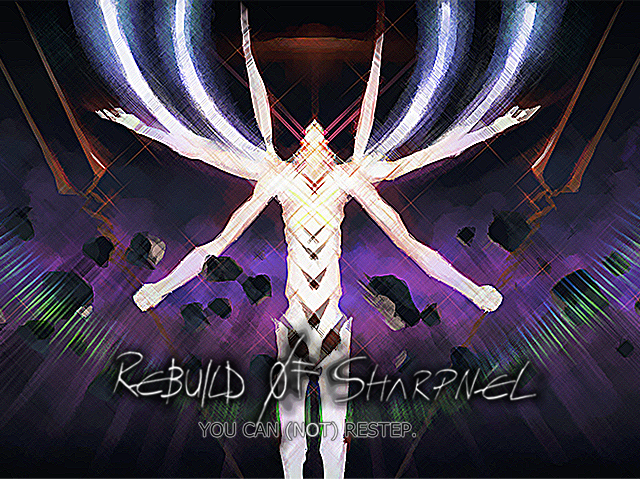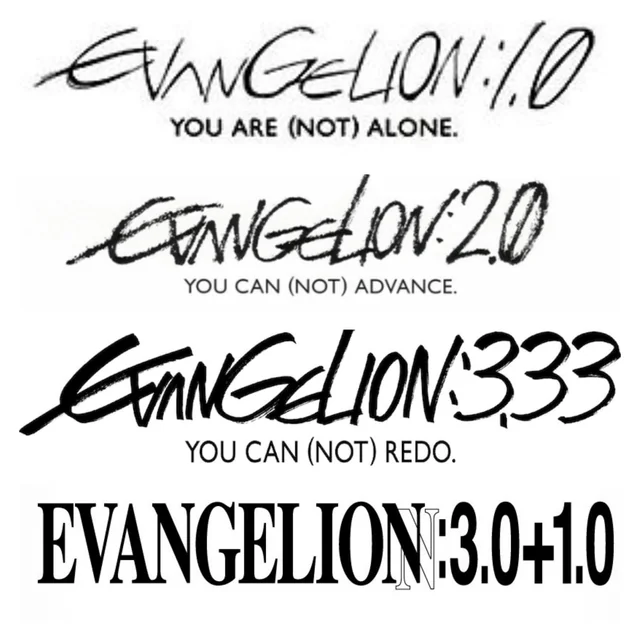
Rebuild of Sharpnel is a stream pack by Zaia.
It is was stepped twice: Rebuild of Sharpnel v1 in 2014, and Rebuild of Sharpnel (proper) in 2017. The v1 version of the pack has never been formally released. The v2, or “proper” version of the pack is the release version.
It is based on the Rebuild of Evangelion Japanese animated film tetralogy.
| Pack Director | Zaia |
| Stepartists | Zaia |
| BPM | 171-250 |
| Songcount | 52 |
| Blocks | 13-21 Full range (13-18 target) |
| Type | Stream |
| Format | Singles |
| Release Date | Jan 03, 2018 |
¶ Structure
Rebuild of Sharpnel contains Medium, Hard and Expert charts for every simfile.
Nearly all the simfiles feature the original songs that DJ Sharpnel sampled from as the preview loops, however this has artificially extended the lengths of all songs and the in-game timer will not show the correct songlengths.
Chart description fields contain the stream breakdown notations.
¶ Development
My first involvement with DJ Sharpnel music goes back to my first pack, S21 Works, and continued through Cirque du Beast and Cirque du Veyron. In late 2012, my charts were then incorporated into the Sharpnelstreamz discography project, and then again in 2013 for Sharpnelstreamz v2. I had always associated myself with Sharpnel's music for pad simfiles , and by Q3 2014, my stepartist abilities had reached a level that I felt like I could embark on a more serious undertaking and step all of Sharpnel myself and complete my personal “journey” with the artist.
The plan was to step every DJ Sharpnel song I liked with the complete freedom to step them however I liked, without being tied to a larger project. I will detail the production of this pack in its two primary production phases:
PHASE 1
Rebuild of Sharpnel v1's production took place during September 2014, starting not long after I had returned from the US for Bearpocalypse 4. The turnaround was rapid because I was using the pre-existing skeletons from Sharpnelstreamz.
It was during this phase that I developed my concept of “value”, one of the most foundational chartwriting principles I work by.
The decision to use alternate preview loops was made during this time. I was inspired to experiment with it by an Aoreo keyboard chart called Reality ~Speedy Long Mix~ from a pack called Yo don't kb quiet that featured a preview loop of the song Reality by The Berzerker sped up to 300bpm, but was in actuality a bait-and-switch to whatever this is. I had a brainwave moment and realized I could take this and apply it to my pack in an interesting way.
PHASE 2
Phase 2 of production took place throughout December 2017; after Cirque du Enzo and Cirque du Jackhummer had both been completed, but I went straight from those packs to this one, so they were back-to-back productions. The songlist nearly doubled in size from 29 to 52 songs and Medium charts were added to all simfiles. During this time I also restepped all of the existing Expert charts from the ground up.
In between phases 1 and 2, Sharpnelstreamz v3 became a thing. Work on that started slowly and in earnest, but ramped up over time. Since I already had my own personal Sharpnel pack, in June 2015 I “released” all prior songs I'd stepped in v1 and v2, and opened them up for new stepartists to write new charts for the v3 pack. I formally remained uninvolved with the project.
¶ Artistic Influences and Chart Design

The Evangelion theming of the pack began with S21 Works, continued with Cirque du Beast and dominates the theme here. It feels notably fitting as DJ Sharpnel has sampled the Evangelion franchise numerous times. Whilst S21 Works and Cirque du Beast reference the tv anime Neon Genesis Evangelion, Rebuild of Sharpnel references the film tetralogy Rebuild of Evangelion, from which the pack obtains its namesake.
The subtitle text “You Can (Not) Restep” on the banner is a reference to the first three Rebuild films being subtitled in a similar manner. The specific one referenced is the third film, which is subtitled “You Can (Not) Redo”.
It was unavoidable that my resteps would resemble the existing charts in some ways - the ways they had patterned the songs were identical to how I patterned them too. It is an interesting exercise in contemplating the nature of the objective and the subjective in the context of stepartistry. The stepping framework is built under the assumption that no two charts are the same, and that art is subjective - that we uniquely perceive and transform music into motion, but when two stepartists independently write the same things, believing earnestly that they are the ideal patterns for any particular sound, it raises curious questions about the nature of the art and what lines exist between objective and subjective forms.
"If the musician can copy-paste their music, I can copy-paste my patterns"
- Zaia, 2014, on DJ Sharpnel
The most significant breakthrough I made with this pack was being enabled the means to deeply explore axis-swapping and 16th shifting. Although I had done this in earlier packs, and other stepartists had done it before me, this was the first time I was really crystallizing it as a “method” for writing streams, and exploring mechanics by which it operated and the effects it had on a chart. Until then, I had always strived to get my patterns as close as possible to the sound- 16th shifting meant intentionally moving your patterns away from the sound, and as such, this was, on paper, not a desirable thing to do. However, in the context of longer streams, and especially in the context of stamina players, it is a net positive gain in chart “value”.
Rebuild of Sharpnel was the first time I considered charts as having some kind of definable “value”. The value of which I speak is not actually a discrete quantity that one could write into the chart description field, but it is nonetheless still a figure of some kind. It is best evaluated when considering its movement rather than its actual quantity. An example of a chart's value in motion can be found in the example of Rebuild of Sharpnel and 16th shifting.
If I write 8 measures of stream, and every pattern occurs on the sound its written to, then we can surmise that the chart has some defined quantity of artistic value. Let's say it has one unit of value right now. These 8 measures of stream have candles that only occur on the left foot (URD/DRU candles). If the music were to repeat itself, and I want to copypaste my patterns, to maintain maximal artistic value, I would therefore need to paste the 8 measures on the same note beat it was on in the prior 8 measures for a clean copypaste. If the stream was written from M8.000-16.000, then a clean copypaste means pasting on M16.000, and the 8 measures will end this section on M24.000.
Now suppose that “value” can be split into different types of value. Let's say “artistic value” and “playability value”. This chart with its 8 measures of stream, with all its candles on the left foot, copypasted once to become 16 measures of stream, but still has all candles on the left foot, has maintained its artistic value (patterns still fall on the sounds perfectly), but its playability value has been compromised, as there are now 16 measures of streams with candles all on the same foot, and this will tire the player's left foot/leg faster than their right foot/leg. It has potentially lost some value, depending on how you personally balance “artistic value” with “playability value”.
Suppose then that we could find a way to salvage some playability value, at the cost of some artistic value. A 16th shift could facilitate this. Instead of copypasting the 8 measures on M8.000, we copy it onto M8.0625 (a single 16th later). The copypaste would have a doublestep if we did this, so we would need to fix this by performing an Axis-Swap. This means swapping notes across one of the two axes (vertical or horizontal, or both). The options for swapping notes are: swap the L and R notes (a horizontal swap), or swap the U and D notes (a vertical swap), both both L/R and U/D (this is what the Mirror option does). If we apply an L/R swap, we will fix the doublestep issue by returning the side notes to the correct sides (to maintain foot parity), and we will also be moving all the left foot candles to the other side, turning them into right foot candles. This will create a state of balance with regards to these 16 measures of stream. 8 measures of candles on the left foot (URD/DRU), and 8 measures of candles on the right foot (ULD/DLU). The trade-off is that these 8 measures of notes are all a 16th later than the music they were originally stepped to. We can conclude that we lost some value by intentionally making some of the patterns “off-beat”, but we gained some value by balancing out the levels of fatigue each foot will receive (before, the left foot would have gotten twice as fatigued as the right foot, and now they are being fatigued in equal measure). In stamina-oriented play, where the focus is playability, I can safely assume I gained more units of “playability value” than I lost in “artistic value”, resulting in a net increase in overall chart “value”.
This concept of “value” is the philosophical foundation of the mechanics of axis-swapping and 16th-shifting. It is the purposeful compromise of one element of stepartistry to gain more than what was lost in another element. Where you choose to make these “value trades” is dependant on the type of chart you are writing, and who your target audience for it is.
¶ Graphics

All of the visual imagery of the pack is heavily Evangelion inspired. There are two primary backgrounds used for the artwork. The first one and the pack banner, is derived from a stitch of screencaps from Evangelion 3.33. The second is from the 2017 teaser poster for 3.0+1.0. All songs that were part of the “v1” (phase 1) version of the pack got the main background, and all the songs that were added in “v2” (phase 2) got the second.
There was a secret hidden background for the song Over The Fullereneshift, which featured an artwork of Evangelion 13 in its awakened state. This image had a lot of the Crosshatch Filter applied in editing. I wish I hadn't.

The title text of the pack was quite difficult to put together. Each of the first three Rebuild films' titles were drawn by Hideaki Anno using a marker, and as such, no “typeface" of them exists. I was able to “construct” the letters I needed
using parts of what was available. My primary source ws the EVANGELION:1.0 text.
For example, the R is a mix of “E”, and two “I” letters; the B is an “I” and a “3”; the U is an “E” rotated 90 degrees with part of an “I” added to the corner; the D is an “I” and an “E” stretched longer; the O is a “0”; the F is three different long segments combined (anything with a long straight line would have been any long components of other letters, like the arms of the “V”, “A”, “N”, “L”, “I” or “1”). The S is two “E”s stitched together; H is any three long segments; and P was built similarly to R. Everything was then placed together and resized to make it look like it too had been organically drawn with a marker.
This pack also marked the first time that I used borders around an artwork to achieve a specific effect. To date, this pack is the only one that has used a white border - all the others have been black.
¶ Songlist
Rebuild of Sharpnel contains 52 songs. Sources for samples were found using this list.
| Song | Artist | BPM | Notes |
|---|---|---|---|
| 30 Minutes Harder | DJ Sharpnel | 171 | Tatu - 30 Minutes |
| Aim Burst | DJ Sharpnel | 191 | fripSide - Only My Railgun |
| Back to the Gate | DJ Sharpnel | 191 | Ayane - Itsumo Kono Basho De |
| BF2014 | DJ Sharpnel | 193 | Utada Hikaru - Beautiful World |
| Blue Army | DJ Sharpnel | 182 | Angela - Separation |
| Burst Linker | DJ Sharpnel | 191 | May'n - Chase the World |
| Calling SGNSN | DJ Sharpnel | 200 | SX has a rogue L note at M247, about 47 seconds after the end of the chart Hiroyuki Sawano - Call Your Name |
| Cyber Inductance | DJ Sharpnel | 191 | Ayako Ikeda - Prism |
| Difficulty-G | DJ Sharpnel | 200 | Sped up from 191bpm Walküre - Ikenai Borderline |
| Dokudenpa | DJ Sharpnel | 188 | Queen - We Will Rock You (5ive cover) The actual preview loop is from episode 1 of Fruits Basket (2001). No YouTube link for the scene. |
| Flower Forever | DJ Sharpnel | 175 | Yoko Ishida - Towa no Hana |
| Future Dominators | DJ Sharpnel | 210 | Yousei Teikoku - Kuusou Mesorogiwi |
| Fuwatanity | DJ Sharpnel | 191 | HO-KAGO TEA TIME - Fuwa Fuwa Time |
| Gate Openerz | DJ Sharpnel | 199 | Kanako Itō - Skyclad Observer |
| Heretic Witch | DJ Sharpnel | 200 | ZAQ - Philosophy of Dear World Sped up from 184bpm |
| Highspeedstar | VJOL | 241 | Unknown source |
| I Have A Bad Case | DJ Sharpnel | 192 | Zuiikin' English - I have a bad case of Diarrhea |
| I'm A Maid (C-Type Remix) | DJ Sharpnel | 250 | Pilko Minami - Maid-san Rock 'n' Roll |
| Innocent Riddle | DJ Sharpnel | 205 | Maaya Uchida - Shoushou Innocence |
| Ivaltek | DJ Sharpnel | 208 | Angela Aki - Kiss Me good-Bye |
| Jersey Spirit | DJ Sharpnel | 186 | Megumi Nakajima - TRY UNITE! |
| Kimochi-E-Koto | Sharpnel.exe | 208 | DJ Sharpnel - Scribble Love (its a self-remix) Makoto Ki Fan - “キモチイイコト” (Feeling Good) (the voice samples are a 20-minute voice-acted drama off of a Sharpnelsound album called Erectortion-01 -Feels good- |
| Klassiker Einheit | DJ Sharpnel | 187 | ChouCho - Yasashisa no Riyuu |
| Little God Ch@nnel | DJ Sharpnel | 189 | Miyuki Takara, Kaori Fukuhara, Konata Izumi, Emiri Katō, Aya Endo, Aya Hirano - Motteke! Sailor Fuku |
| Lost Connections | DJ Sharpnel | 185 | ClariS - Connect |
| Lovelyteks | DJ Sharpnel | 189 | Lisa Johnson - Love Dan-E-O - Sekkle Down |
| Magic Cycles | DJ Sharpnel | 197 | ClariS - Connect |
| Maginobionics | DJ Sharpnel | 186 | ZAQ - Sparkling Daydream |
| Marunouchi Surviver | DJ Sharpnel | 200 | Triple H - Rock Over Japan |
| Mishima Mecanica | DJ Sharpnel | 202 | Kemeko (Chiwa Saitou) - Purippurin Taisou |
| Moonearth | DJ Sharpnel | 190 | Aki Okui - Tsuki no Mayu (Moon's Cocoon) |
| Nergal Burning | DJ Sharpnel | 187 | Matsuzawa Yumi - You Get To Burning |
| Noiseman | Zutsuu | 190 | NOISEMAN SOUND INSECT |
| Over the Fullereneshift | DJ Sharpnel | 204 | Utada Hikaru - Sakura Nagashi |
| Pacific Girls | DJ Sharpnel | 195 | Kantai Collection OST - 母港 (Home Port) |
| Pretty Green Onions | DJ Sharpnel | 194 | Ievan Polka - Loituma |
| Shihen | DJ Sharpnel | 198 | Savage Genius - いつか溶ける涙 (Itsuka Tokeru Namida) |
| Shind Bad | DJ Sharpnel | 198 | Pink Lady - Nagisa No Sindbad (W cover) |
| Stay In Your Room With K | DJ Sharpnel | 210 | Unknown source |
| Strangeprogram | DJ Sharpnel | 215 | DROPS - Bakappuru |
| Subaru in the Wind | DJ Sharpnel | 187 | Miyuki Nakajima - Chijō no Hoshi" |
| Subconscious Girl Koishi | DJ Sharpnel feat. Ai Ohsera | 190 | Unknown source, but definitely from Touhou |
| Tactical Railroad | DJ Sharpnel | 205 | Minori Chihara - While We Are Struck In the Headwind |
| The Others | DJ Sharpnel | 184 | Chiaki Ishikawa - Uninstall |
| The Power of Underground | DJ Sharpnel | 195 | Shōko Nakagawa - Sorairo Days |
| Titanics Maneuver | DJ Sharpnel | 200 | Linked Horizon - Guren No Yumiya |
| Vergina | DJ Sharpnel | 205 | SM: The chart breakdown lists 8*/16*/16/16* and the chart itself is 1/4-3/7/7-7-7-24/15Koza Mostra & Agathon Iakovidis - Alcohol Is Free |
| W | DJ Sharpnel | 179 | Sasagawa Miwa - Warai |
| We Luv Lama | DJ Sharpnel | 210 | Delay Lama plugin VST by Audionerdz Preview loop is from Bearpocalypse 3 |
| World Sound | DJ Sharpnel | 180 | Maaya Sakamoto - Hemisphere |
| Xing Breaker | DJ Sharpnel | 198 | Eir Aoi - Sirius |
| Zap Your Channel | DJ Sharpnel | 212 | Oranges & Lemons - Soramimi Cake Mikuni Shimokawa - Tomorrow Rie Kugimiya - Hajimete Shimashou Ami Koshimizu - Que Sera, Sera Yui Horie - It's My Style |
¶ Reception and Retrospect
Rebuild of Sharpnel v1 existed on very few machines. i have heard of random copies of it showing up here and there. I recall that the most outlandish place I heard it was on was on a machine in France in 2016 or so. I played it very frequently myself, and it consituted many of my longer stamina sessions.
I never felt much motivation to release it as an official Zaia pack because I didn't see much value in doing so. It was, first and foremost, a pack for me to play, and there were already perfectly fine charts to these same songs in Sharpnelstreamz, so I felt it was for the best to keep this pack and enjoy it privately. One other major factor was the inconsistent songlengths caused by the inclusion of the samples as the loops. My rationale changed in the lead-up to Cirque du Enzo's release. I figured it would be good to ship the second-tier packs I had in waiting (Cirque du Jackhummer as well) and get them out, but release them as extras in deference to the major release. This is how the Enzo + Rebuild + Jackhummer triple release came about.
Rebuild of Sharpnel (proper) released to healthy positive feedback and a solid player reception. This pack has a lot of committed fans- I notice that when people play this pack, they play a lot of it. It is compared favorably with Sharpnelstreamz v3, its closest contemporary. Its release was intentionally made secondary in favor of Enzo, and it received zero promotion.
Anybody who knows anything about me knows that I am an Evangelion superfan - subsequently, I am very attached to this pack; in part because of the Evangelion theming, but also because of the considerable creative gains this pack facilitated for me. I consider it one of the most important packs in my simfilography for how it introduced me to “value”, and “value trades” have become a stepping mechanic I exercise with nearly every chart I write.
¶ Trivia
- Despite not being the first released, Rebuild of Sharpnel was the first project of mine that was totally themed around a media franchise
- Rebuild of Sharpnel's theming pre-dates Helblinde's by one month
- The use of the term “Rebuild” in the context of restepping charts started here
- The “(2016 Rebuild)” charts in Helblinde 2016 (Aura and Heaven's Fall)
- The “(2019 Rebuild)" chart in Helblinde PDTA (Grief and Malice)
- Unbuild of Sharpnel (2022) references this pack's title by being its “inverse” (the source songs are the ones that got stepped)
- My own pack Zaia's Dance Dance Rebuild (2023) is a reference to Rebuild both in name and concept (it features resteps of Dance Dance Revolution songs)
- Difficulty-G and Heretic Witch are both sped up to 200 bpm because I first heard these songs in SRPX-0004, which is 203 bpm. I preferred how they sounded at this speed than they did at their native speeds
- Moonearth is the chart that motivated the creation of the
|symbol for the Stream Breakdown Notation System. The reason is because I wanted a means of identifying the two largest breaks within the simfile, and that these breaks represented a “full reset” of stamina, which the/symbol alone was showing its limits of effectively representing - Vergina SM was supposed to be the chart depicted in its breakdown, rather than the substantially more difficult chart that it is
- A fix for the song length issue was developed by Archi in 2018, but has yet to be applied to the ogg files
- But it is possible to solve this
- This pack went through QA when I watched every chart on autoplay on 1.7x rate
- I was still writing charts in StepMania 3.9, which didn't have roll functionality, so I would draft rolls as holds and convert them one by one later. I would have to keep written notes of which charts had them. These notes are from the v1 version of the pack
- I am open to restepping Sharpnel again, to compare how over the years my style has evolved further